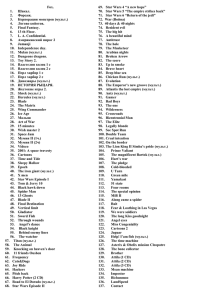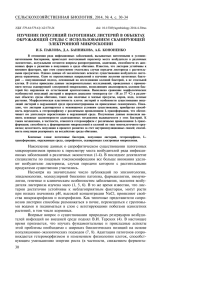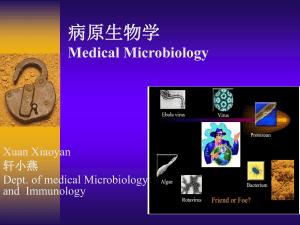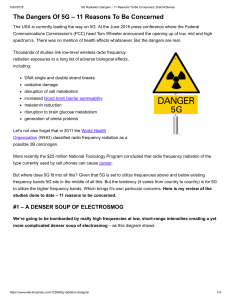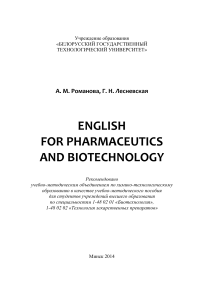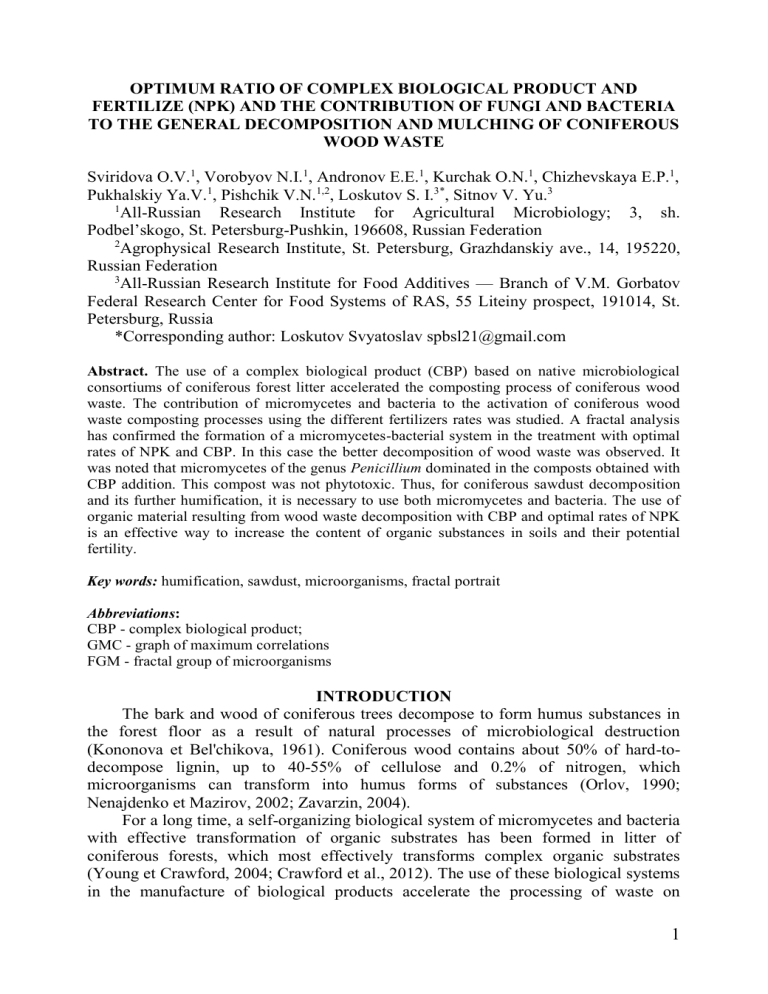
OPTIMUM RATIO OF COMPLEX BIOLOGICAL PRODUCT AND
FERTILIZE (NPK) AND THE CONTRIBUTION OF FUNGI AND BACTERIA
TO THE GENERAL DECOMPOSITION AND MULCHING OF CONIFEROUS
WOOD WASTE
Sviridova O.V.1, Vorobyov N.I.1, Andronov E.E.1, Kurchak O.N.1, Chizhevskaya E.P.1,
Pukhalskiy Ya.V.1, Pishchik V.N.1,2, Loskutov S. I.3*, Sitnov V. Yu.3
1
All-Russian Research Institute for Agricultural Microbiology; 3, sh.
Podbel’skogo, St. Petersburg-Pushkin, 196608, Russian Federation
2
Agrophysical Research Institute, St. Petersburg, Grazhdanskiy ave., 14, 195220,
Russian Federation
3
All-Russian Research Institute for Food Additives — Branch of V.M. Gorbatov
Federal Research Center for Food Systems of RAS, 55 Liteiny prospect, 191014, St.
Petersburg, Russia
*Corresponding author: Loskutov Svyatoslav spbsl21@gmail.com
Abstract. The use of a complex biological product (CBP) based on native microbiological
consortiums of coniferous forest litter accelerated the composting process of coniferous wood
waste. The contribution of micromycetes and bacteria to the activation of coniferous wood
waste composting processes using the different fertilizers rates was studied. A fractal analysis
has confirmed the formation of a micromycetes-bacterial system in the treatment with optimal
rates of NPK and CBP. In this case the better decomposition of wood waste was observed. It
was noted that micromycetes of the genus Penicillium dominated in the composts obtained with
CBP addition. This compost was not phytotoxic. Thus, for coniferous sawdust decomposition
and its further humification, it is necessary to use both micromycetes and bacteria. The use of
organic material resulting from wood waste decomposition with CBP and optimal rates of NPK
is an effective way to increase the content of organic substances in soils and their potential
fertility.
Key words: humification, sawdust, microorganisms, fractal portrait
Abbreviations:
CBP - complex biological product;
GMC - graph of maximum correlations
FGM - fractal group of microorganisms
INTRODUCTION
The bark and wood of coniferous trees decompose to form humus substances in
the forest floor as a result of natural processes of microbiological destruction
(Kononova et Bel'chikova, 1961). Coniferous wood contains about 50% of hard-todecompose lignin, up to 40-55% of cellulose and 0.2% of nitrogen, which
microorganisms can transform into humus forms of substances (Orlov, 1990;
Nenajdenko et Mazirov, 2002; Zavarzin, 2004).
For a long time, a self-organizing biological system of micromycetes and bacteria
with effective transformation of organic substrates has been formed in litter of
coniferous forests, which most effectively transforms complex organic substrates
(Young et Crawford, 2004; Crawford et al., 2012). The use of these biological systems
in the manufacture of biological products accelerate the processing of waste on
1
woodworking enterprises into organic fertilizers (Lozanovskaya et al., 1987; Six et al.,
2006; Baldock, 2007; Fageria, 2012; Singh et Nain, 2014; Hatfield et Walthall, 2015).
That improves the environmental situation around these enterprises, as well as gets
some economic effect from the introduction of fertilizers in agricultural production.
Otherwise, deposits of wood waste will release toxic phenolic compounds into the
environment, worsening the environmental situation around them.
One way to enhance the decomposition of crop residues can be obtained by
processing of microbiological inoculants containing high efficiency of
microorganisms-destructors (Rusakova, 2016; Wu. et al., 2017). Meanwhile, for the
decomposition of organic substrates and further humification, it is necessary to use a
micromycetes and bacteria (Kaszab et al., 2011; Sviridova et al., 2016; Fan et al., 2017;
Leow et al., 2018). In the content of organic fertilizers obtained from wood waste
humus substances are present (Vallini et al., 1997). Enzymatic systems of
micromycetes of the genera Trichoderma, Aspergillus, Penicillium and cellulolytic
bacteria can participate in the biosystem transformation of wood wastes into humus
substances (Imsheneczkij, 1953; Nannipieri et. al., 2003; Emcev et Mishustin, 2006).
Destruction of lignin during decomposition of wood wastes is carried out in the
presence of oxygen by multi-stage biochemical transformation of organic wood
molecules into low-molecular compounds by enzyme systems of fungi and bacteria. In
this case, the contribution of micromycetes to decomposition of wood wastes is of
particular importance, since their mycelium is able to penetrate into the cell structures
of wood and provide direct contact of bacteria and their enzymes with organic
molecules of plant cells from the inside (Skryabin et al., 1986; Vedenyapina et al.,
2010). Thus, only in the self-organizing biological system (Young and Crawford, 2004;
Crawford, 2012) when bacteria and micromycetes act together, the most rapid and
organized transformation of wood wastes into humus substances will occur (Kumar,
Shweta, 2011; Vorobyov et al., 2011).
In addition, there was an evidence that lignin degradation into phenols and other
humic acid precursor substances can promote the formation of humic acid (Wu et al.,
2017).
To decompose the bark of coniferous trees from the forest floor of coniferous
forests, micromycetes and degrading bacteria were isolated, which served as the basis
for a complex biological product (Patent No. 1792974 'Method of decomposition of
wood') (Sviridova et al., 1993). To develop the application technology for CBP, a multi
- sided study of the mechanisms of functioning of isolated lignin destructors when
converting wood waste into humus substances and the principles of organizing
micromycetes-bacterial biosystems in which biochemical processes must be supported
by effective and coordinated actions of biosystem components was required.
The goal of these studies was to determine the optimal rates of CBP and fertilizers
(NPK) and investigate the contribution of micromycetes and bacteria to joint
decomposition and humification of coniferous wood waste.
MATERIALS AND METHODS
CONTENT OF CBP
The CBP contains lignin-degrading microorganisms isolated from decaying wood
located on the soil of forest litter (Sviridova et al., 2001). The total number of
microorganisms of CBP is about 107 CFU ml-1, of which 103 CFU ml-1 of
2
micromycetes, 5.0 ×106 CFU ml-1 of proteolytic bacteria, 4.0 ×106 CFU ml-1 of
amylolytic bacteria, 1.0 ×106 CFU ml-1 of oligotrophs, and 9.0 ×104 CFU ml-1 of
cellulolytic bacteria. Dominant cultures of CBP were identified and deposited in
ARRIAM collection (RCAM): Penicillium chrysogenum (Thom 1910) OH 4 RCAM
00741 and Pseudomonas fluorescens 7 RCAM 00537. Sequences was obtained and
deposited in GenBank, (GenBank Accession Numbers: MT156331 for Penicillium
chrysogenum and MT156340 for Pseudomonas fluorescens). The dominant
micromycetes Penicillium chrysogenum (Thom 1910) OH 4 RCAM 00741 and
bacteria Pseudomonas fluorescens 7 RCAM 00537 possessed of high catalase, oxidase,
cellulase, proteolytic activities and were aerobes.
IDENTIFICATION OF DOMINANT CULTURES
Identification of dominant cultures was performed by PCR-amplification and
sequencing of 16s rRNA fragment (for bacteria) and internal transcribed spacer (ITS)
region (for micromycetes). The 16S rDNA gene was amplified using primers 27F (5′AGAGTTTGATCMTGGCTCAG-3′) and 1525R (5′-AAGGAGGTGWTCCARCC3’). The ITS region of the nuclear ribosomal RNA gene was amplified with primers
ITS1
(5'-TCCGTAGGTGAACCTGCGG-3')
and
ITS4
(5'–
TCCTCCGCTTATTGATATGC-3’) (White et al., 1990). PCR-fragments were
extracted from 1% agarose gel (Onishchuk et al., 2015) and sequenced using the ABI
PRISM 3500xl (Applied Biosystems, Waltham, MA, USA) according to the
manufacturer’s instructions. Homology searches were carried out using the BLASTn
program
(Altschul
et
al.,
1990)
in
NCBI
GenBank
database
(https://blast.ncbi.nlm.nih.gov/Blast.cgi). The dominant microorganisms were
identified also with using a morphological and biochemical characteristics by standard
methods (Raper et al., 1949; Holt J., 1980; Bilaj et al., 1982; Tepper et al., 1993).
EXPERIMENTAL DESIGN
The model composting experiments with coniferous sawdust of and different
NPK rates were carried out during 20 days in aerobic conditions with daily mixing.
The sawdust of coniferous trees from sawmill (Leningrad region, Russia) was used. 15
g of air-dry mass sawdust was placed into plastic container and was distributed in
triplicate The humidity of compostable sawdust was maintained to 60%, average
temperature of the composting was +20°C. The NPK rate (per 100 g of air-dry mass of
sawdust) was corresponded to: NH4NO3 - 5.7 g; KH2PO4 - 2.6 g; CaCO3 - 0.15 g and
CBP rate is 10 ml per 100 g of air-dry mass of sawdust. Sawdust was treated with
NPK and CBP.
The scheme for composting included the following experimental treatments: 1)
NPK; 2) 1/2 NPK; 3) NPK + CBP; 4) NPK + 1 / 2CBP; 5) 1/2 NPK + CBP; 6) 1/2
NPK + 1 / 2 CBP.
ANALYTICAL METHODS
Microbiological and chemical analyzes of the composted mass of sawdust were
carried out at the end of the experiment, on 20 days of composting. A decrease in Corg
may be explained by the decomposition of organic matter. Therefore, the degree of
decomposition of composted sawdust was evaluated by the loss of organic C. The
degree of humification was evaluated by the amount of humic substances formed
3
(fulvic acids and humic acids), as well as by the change in the physical characteristics
of composted sawdust (by darkening, compost friability and degree of sawdust
destruction).
ASSAY THE COMPOSTS TOXICITY
We used a biological test method to assay the toxicity of the composts. The
radishes were grown for 3 days in Petri dishes with an extract from the finished
compost. 1 g of a compost sample was taken and placed in a flask with 50 ml of water,
mixed thoroughly, and then radish seeds were soaked in the resulting filtered solution
for one day. After that, radish seeds at the rate of 25 pieces were placed on Petri dishes
(4 replicates in each treatment) with filter paper humidified with 10 ml of water.
MICROBIOLOGICAL TESTS
Accounting for various groups of microorganisms in samples of compost
treatments was carried out according to the formation of colonies on standard media
(Netrusov, 2005). The numbers of colonies of microorganisms were counted on:
micromycetes - on Chapek medium with lactic acid, proteolytic bacteria - on meat peptone agar; amylolytic bacteria - on starch-ammonia agar; oligocarbofiles - on
starvation agar and cellulolytic bacteria - on a liquid Hetchinson’s medium with filter
paper (Tepper et al., 1993). 10 g of each compost samples were placed into flasks with
100 ml distilled water and shaken on for 30 minutes. Serial dilutions from 10 -2 till 10- 6
for each sample were prepared 1 mL dilutions were plated to the Petri dishes. Deep
passages were made. Plates were incubated at +25°C during six day and for cellulolytic
bacteria – during twenty one days, and colony forming units (CFUs) were counted.
ASSAY OF CHEMICAL PARAMETERS OF COMPOSTS
The chemical parameters of composts were determined by the following methods:
Total nitrogen content (Ntotal) in compost was determined by digesting the samples in
sulfuric acid (H2SO4) followed by Kjeldahl analysis on Kjeltek apparatus (Tekator,
Sweden) (Bremner et Mulvaney, 1982). Nitrates content (N-NO3) was assayed by
photometric method with the phenoldisulfonic acid on KFK-2 electro photocolorimeter
(Peterburgskij, 1975). CO2 content was assayed on a gas chromatograph ('Tsvet-110',
Russia), katharometer was a detector, helium was a carrier gas.
HUMUS FRACTIONATION
Humus fractionation was performed and the content of humus compounds was
determined by the modifications method (Canellas & Façanha, 2004). Samples were
treated with 2 mol L-1 o-phosphoric acid to separate the free fulvic acids fraction.
Humic fraction was extracted by adding 100 mL of 0.1 M NaOH plus 0.1 M Na4P2O7
to 10 g sample and shaken for 16 hours. The dark-colored supernatant solution was
separated by centrifugation at 3,000 g for 30 min. The residue was resuspended in 50
mL of 0.1 M NaOH plus 0.1 M Na4P2O7 then shaken for 4 hours. The solution was
centrifuged again and the supernatant was added to the supernatant collected
previously. The extracted alkaline solution containing dissolved humic and fulvic acids
was acidified to pH 1.0-1.5 with H2SO4. After 12 hours at 8ºC the extract was
separated into soluble and insoluble parts by centrifugation. After fractionation the
4
content of organic carbon in the soluble humified organic matter was determined.
Content of organic carbon (Corg) – by oxidation with potassium dichromate by
Tyurin method (Orlov & al., 1995). Compost samples were dichromate digested with
10ml 0.4 N oxidizing solution (K2Cr2O4:H2SO4=1:1) by applying in external heat of
1500C for 20 min in presence of catalyzer Ag2S04; the using oxidizing agent was
determined by titration with Fe(NH4)2(SO4)·6H2O using phenylanthranilic acid as an
indicator.
DATA ANALYSIS
The experimental data were analyzed using variance, correlation and fractal
statistical analysis (Rajzin, 1980; Lakin, 1990; Kronover, 2006). Cluster analysis was
used to determine the main factor in grouping experiment treatments into clusters.
Euclidean distance was used for data points. The distance between the points and the
clusters was estimated using the distant neighbor algorithmic method (Sneath & Sokal,
1973). Correlation analysis was used to calculate the values of the matrix of pair
correlations between the measured chemical and microbiological characteristics of
composts, using vectors of variation of the values of these characteristics in six
experimental treatments. The maximum correlation graph was constructed based on the
lower limit of the module of the values of the correlation coefficient is equal to 0.5
(Vorobyov et al., 2006). Fractal analysis modified was used to assess the participation
of various physiological groups of microorganisms in the joint transformation of
organic substrates.
When three physiological groups of microorganisms arrange on a straight line
they are selected as fractal object and named as fractal group of microorganisms
(FGM). The frequencies of microorganisms in FGM are the numerical power series
(for example, 0.1; 0.01; 0.001). We assume that FGM is an indicator of the biological
system organization of microorganisms. When the FGM arrive, three points into fractal
portrait arrange on a straight line. Microorganisms of different physiological groups are
represented by points on the fractal portraits. The coordinates of these points depend on
the logarithms of their frequencies (Vorobyov et al., 2019). This method allows
determining of groups microorganisms involved in biological system processes.
The index of microbial bioconsolidation was calculated on the basis of a
topological analysis of the location of groups of microorganisms in fractal portraits
(Fig. 3). The total number of groups of microorganisms (N0 = 4) represented in the
portraits was taken into account, excluding the point located at the origin (X = 0, Y =
0). The number of groups of microorganisms (NF) represented in the portraits and on
the dotted lines was taken into account, excluding the point located at the origin (X =
0, Y = 0). The Index of Microbial Bioconsolidation (IMB) was calculated using the
following formula:
IMB = NF / N0
The IMB values for the treatments of the experiment are presented in Table 1. In
the same table, the correlation coefficients of IMB with the measured characteristics of
the compost are presented.
MICROBIOLOGICAL AND CHEMICAL DATA OF THE
EXPERIMENTS
5
The microbiological and chemical data of the experiments on the humification of
wood waste are shown in Table 1. The content of microorganisms in composts content
was about 106 CFU g-1. The participation of different groups of micromycetes and
bacteria in the transformation of coniferous sawdust was revealed. In treatments No. 36 (with addition of CBP) the most effective composting of sawdust was noted. In these
treatments, the dominant microorganisms were micromycetes Penicillium
chrysogenum (Thom 1910), which reached up to 80-90%. The number of Trichoderma
viride (Pers 1794) amounted 10%. Among bacteria Pseudomonas fluorescens was
dominated. The increased abundance of Penicillium chrysogenum (Thom 1910) and
Pseudomonas fluorescens in the microbial community of composted material indicated
their joint action in sawdust decomposition. These bacteria also were dominant in
microbial community of CBP.
It was noted that the application of NPK increased the total number of
microorganisms due to increasing of micromycetes, proteolytic bacteria, and
cellulolytic bacteria. In treatments No. 1 and No. 2 (without CBP) the number of
phytopathogenic micromycetes Fusarium oxysporum (Schltdl 1824) and Fusarium
culmorum (Wm.G. Sm., Sacc. 1892) reached to 50%. Whereas as the number of
micromycetes of other genera consisted: for Penicillium - 20%, for Trichoderma (T.
viride Pers., 1794) –10-20%, for Aspergillus (A. niger Tiegh., 1867) - 10%, for Mucor
- 1-5%. In that case a dominant bacteria were Bacillus. Thus, in treatments without
CBP the micromycetes of the genus Fusarium prevailed.
The decrease of Corg content in composts average by 6% (from 48 to 42%) in
comparison with the sawdust was revealed, that in all composts there was a decrease
in Corg from 48% (initial sawdust) to 42% (experience). It confirms the active
decomposition of sawdust when using of NPK. The experimental treatment with
addition of NPK (in maximal rate) and CBP had the best indicators for substrate
decomposition, the destruction of sawdust was better and compost has high degree of
destruction.
A small content of fulvic acids was detected in all treatments. In the treatment
No.1 (NPK) the content of fulvic acids was 0.03%. In treatment No. 2 (1/2 NPK) the
content of fulvic acids was 0.01%, but humic acids were not found. However, in the
treatments with addition of CBP the presence of humic acids was detected. In treatment
No. 3 (CBP + NPK) the content of fulvic acid was 0.12% and the content of humic
acid was 0.02%. In treatments No. 4-6 the content of fulvic acids was 0.07% and
humic acids was 0.01%.
The composts obtained in experimental treatments with CBP stimulated biomass
of radish seedlings up to 10% and radish seeds germination was 100%. In the same
time in treatments No.1 and 2 (without CBP) radish seeds germination was only 9597%.
It was noted that the intensity of CO2 emission during composting was lower in
the treatment without the use of CBP and with a full dose of nitrogen (No. 1) - at the
level of 0.20-0.29%. This may be due to denitrification processes, which can occur at
low respiration rates. This is also indicated by a decrease in the content of N-NO3 in
the compost of this treatment relative to others. In the treatment with a half dose of
nitrogen (No. 2), the respiration rate gradually increased to 0.35%, which may be due
to longer processes of microbiological decomposition of the sawdust.
6
With a decrease of the application rate of CBP (1/2 CBP), the respiratory rate also
decreased. The increased activity of CO2 emission in the early stages of composting in
treatments with CBP indicate an intensification of the decomposition of sawdust by the
CBP community of micromycetes and bacteria initiated by CBP.
It was noted that in compost of treatment No. 1 (NPK) was a sufficiently high
contents of micromycetes, proteolytic bacteria and cellulolytic microorganisms, but the
degree of humification of sawdust was lower than in treatments with CBP. In treatment
No. 6 (1/2 NPK + 1/2 CBP) with a good degree of humification of the substrate, a
higher content of micromycetes was noted than in other treatments with addition of
CBP, but the number of cellulolytic microorganisms was lower than in treatment No. 3
(CBP and NPK), i.e. degrading processes slowed down.
Meanwhile, in the optimal treatment No. 3 (NPK + CBP), the number of
proteolytic and amylolytic microorganisms was average, but the content of cellulolytic
microorganisms was twice higher compared to treatments No. 2, No. 4, No. 5 and No.
6 with a fairly high number of micromycetes.
Probably, a biosystem of microorganisms formed in this ratio could be optimal for
the processes of humification. This may indicate the influence of the micromycetebacterial complex of CBP (contains a biosystem community of lignin destructors) on
the activation of the processes of transformation of lignocellulosic substrates into
humic substances.
RESULTS OF DATA ANALYSIS
As a result, of the cluster analysis of the characteristics of the experimental
treatments, a dendrogram was constructed (Fig. 1) and the factors uniting the
experimental treatments into clusters were determined. It noted that the treatments with
NPK (No. 1 and No. 2) and without CBP did not form a cluster, two clusters formed
when CBP was add. Treatments No. 3 and No. 4 (with full dose of NPK) united into
the first cluster. Treatments No. 5 and No. 6 (with 1/2 NPK) conform the second
cluster. Thus, the main factor in the clustering was NPK rates, which unite these
treatments into clusters.
The analysis of pair correlations of the compost’s characteristics and microbial
community data (Table 1) made it possible to single out the highest absolute
coefficients of correlations and construct a nondirected graph of maximum correlations
(GMC, Fig. 2). It was taken into account the absolute value of the correlation
coefficients should exceed 0.5. GMC demonstrates the relationship (r = 0.89) of
micromycetes (1) with cellulolytic bacteria (5), which indicates their joint participation
in the decomposition of lignocellulose from sawdust. The absence of a connection
between amylolytic bacteria (3) and other components of the biosystem means that this
group of microorganisms does not take an active part in biosystem processes of
composting. Their activity requires readily available carbohydrates that have not
formed in the right amount. GMC demonstrates that proteolytic bacteria (2) and
oligocarbofilic bacteria (4) act in a close correlation ligament (r = 0.76), actively
participating in the processes of transformation of the organic substrate.
Oligocarbofilic bacteria (4) with active oxidoreductases participate in the
decomposition of lignin together with proteolytic bacteria (2) (r =0.76) and decrease
the Ntotal (6) (r = -0.67). Micromycetes (1) and cellulolytic bacteria (5) also act in
conjunction (r = 0.84) destroying polymer organic molecules in compost. In this case
7
N-NO3 (7) is consumed and the connection with Ntotal (6) (r = 0.69) is strengthened
with an increase in its dose. Thus, two groups of microorganisms (2)-(4) and (1)-(5)
perform the main function of the destructive biosystem. The use of CBP (12)
accelerates composting processes, which is reflected in an increase in the level of
humification of compost (9) (r = 0.83). A decrease in the total number of micromycetes
(1) when using CBP (12) indicates that micromycetes function in the composition of
biosystems with a smaller number (r = -0.81), but with a greater efficiency of further
biochemical transformations of organic substrates and with reducing of consumption of
energy and nutrient resources.
To assess the extent of participation of the functional groups of microorganisms
in biosystem processes, we used a fractal analysis of microorganism's amount. For this,
the fractal portraits of microbial communities were constructed (Fig. 3). In fractal
portrait points represent the groups of microorganisms with coordinates depending on
the frequency of occurrence of the corresponding microorganisms. The topological
analysis of the arrangement of points in a fractal portrait showed that some groups of
three points (triplets) are located on straight lines. We assume that this arrangement of
points is a nonrandom event, and it indicates the formation of a biosystem by the
corresponding groups of microorganisms. The absence of (1)-(5) or (2)-(4)
microorganism’s groups in triplets in treatments No. 1 and No. 2 (without CBP, Fig. 3a
and 3b) demonstrated the absence of CBP influence on biosystem processes. The
location of micromycetes (1) in the upper part of the fractal portrait demonstrate low
efficiency of waste humification the in treatments No. 1 and No. 2 (Fig. 3a and 3b). In
treatments No. 3 (CBP + NPK, Fig. 3c) and No. 6 (1/2CBP + 1/2NPK) (Fig. 3f), all
points depicting trophic groups of microorganisms are covered by straight dashed lines,
i.e. these microorganisms form common biosystems. We believe that in these
treatments, the biosystems are formed and micromycetes (1) take part in biosystem’s
processes in the first positions, at the very beginning of composting, since they are
located in the lower part of the fractal portraits.
DISCUSSION
The microbiological transformation of wood wastes from the woodworking
industry into substances makes it possible to solve ecological problem and agricultural
fertilizing. To increase the efficiency of microbiological transformation of wood waste
into humic substances, it is necessary that the microbial community forms an active
destructive biosystem. Microorganisms in the composition of sawdust destructive
biosystems transform organic substrates in an organized and orderly manner, evenly
distributing the enzymatic load among the participants of a conversion processes. Since
microorganisms in the composition of biosystems transform organic substrates in an
organized and orderly manner, evenly distributing the enzymatic load among the
participants in the conversion process. For example, in consortium of cellulolytic and
oligocarbofilic bacteria in soils, bacteria are consistently responsible for the hydrolytic
degradation of complex high-molecular nitrogen-free organic substances (cellulolitic),
as well as for the redox processes of transformation of residual products into humus
links (oligocarbofiles). Such active destructive biosystem was formed in sawdust
composts obtained with addition of CBP (Kozlov et al., 2017). For fast humification of
composts the optimal ratio between the numbers of different groups of microorganisms
should be set. The active destructive CBP biosystem (which containse a micromycetes,
8
proteolytic, cellulolitic and oligocarbofilic bacteria) activated the processes of
transformation of lignocellulosic substrates into humic substances. The increasing of
activity of CO2 emission in the early stages of experiment in treatments with addition
of CBP indicated the increasing of decomposition of sawdust.
Before composting experiments, a long cultivation of the microbial community
was carried out, and the micromycetes-bacterial biosystem was selected for CBP. The
fractal portrait (Fig. 3G) confirmed the systemic consolidation of microorganisms in
the CBP.
It is noted, that the compost from other treatments (without addition of CBP)
decreased the total mass of radish seedlings below the control on 5%. Because in these
composts dominated the phytopathogenic micromycetes of the genus Fusarium.
Whereas the toxicity of composts obtained with addition of CBP was eliminated.
Because in biosystems of these composts Penicillium chrysogenum (Thom 1910) and
Pseudomonas fluorescens were dominated. The possibility of suppressing soil plant
pathogens using compost has been widely studied (Noble and Coventry, 2005:
Pugliese et al, 2010). Compost quality is also related to the concentration of humic
substances in the final product; thus, determining humification progress is essential for
evaluating composting process (Kulikowska and Sindrewicz, 2018). Composts
obtained with addition of CBP had a high degree decomposition and small content
humic acids, which depend on the composting time. Humic substances increase a soil
fertility (Vergnoux et al., 2011).
The dendrogram (Fig. 1) demonstrates the dependence of sawdust composting
and transformation into humic substances on rates of NPK and 1/2 NPK, because two
different cluster are formed with these rates. When using CBP, the NPK and 1/2NPK
rate determines the biochemical characteristics of the destructive processes and the
number of microorganisms involved in these processes. Apparently, the low dose of
NPK is necessary to start of destruction and to grow of microorganisms in the required
quantitative ratio.
The graph of maximum correlations (Fig. 2) shows the formation of two binary
microbial complexes in a destructive biosystem: (1)-(5) – micromycetes and
cellulolytic bacteria, (2)-(4) – proteolytic bacteria and oligocarbofiles. The greatest
emission of CO2 and decomposition of the composted mass were recorded in
experimental treatment No. 3. Based on this data it can be argued that in experimental
treatment No. 3 the (2)-(4) microbial complex acts maximal effectively, which
determines the highest intensity of the processes of transformation of the organic
substrate in humic substances. At the same time, the (1)-(5) microbial complex
increases the nitrogen content in humic organic mass that increases its fertilizing
properties.
Fractal portraits of microbial communities of compost masses showed that in the
experimental treatments No. 3, 4, and 6 (Fig. 3c, 3d, 3f) biosystems similar to CBP
biosystem (Fig. 3g), were formed. But, in the experimental treatments No. 1, 2 (Fig. 3a,
3b) this biosystems were not formed. This indicates that the addition of CBP
stimulated the formation of microbial biosystems in composts.
This confirmed also by emitting of a greater amount of CO2 (45, 33, 30% per g of
compost and per day) in these experimental treatments.
The correlation of IMB with the compost decomposition scores (feature 9,
9
r = 0.68) indicates an increased importance of the biosystem organization of the
microbial community for accelerated composting of wood waste.
CONCLUSION
The micromycetes closely interacted with cellulolytic, oligocarbofiles and
proteolytic bacteria during composting of sawdust of coniferous trees. The
micromycetes closely interacted with cellulolytic, oligocarbofiles and proteolytic
bacteria during the process of coniferous sawdust decomposition. As a result, fulvic
acids and humic acids were formed.
The addition of CBP during coniferous sawdust composting resulted in
production of a high-quality non-toxic compost and in micromycetes-bacterial
biosystem (similar to the biosystem in CBP) formation. The optimal rates of CBP and
fertilizers (NPK) for composting were determined. The fractal portrait demonstrated
the formation of a micromycetes-bacterial system when NPK and CBP were applied.
ACKNOWLEDGEMENTS
This work partially was supported by a subsidy of the Ministry of Education
and Science of the Russian Federation No. 0664-2019-0025 and No. 07501190-22-00.
The research was performed using equipment belonging to the Core Centrum
“Genomic Technologies, Proteomics and Cell Biology” of All-Russia Research
Institute for Agricultural Microbiology.
REFERENCES
Altschul, S.F., Gish, W., Miller, W., Myers, E.W. and Lipman, D.J., 1990. Basic Local
Alignment Search Tool. Journal of Molecular Biology, 215, 403-410.
https://doi.org/10.1016/S0022-2836(05)80360-2 .
Baldock, J.A. 2007. Composition and cycling of organic carbon in soil. In nutrient
cycling in terrestrial ecosystems. P. Marschner and Z. Rengle (eds), SpringerVerlag,
Berlin,
Heidelberg,
Soil
Biology,
Sec.
10,
1–35.
https://doi.org/10.1007/978-3-540-68027-7
Bilaj, V.I., 1982, (eds). Methods of experimental mycology. Kiev: Naukova dumka,
550 p.
Bremner, J. M. et Mulvaney, C.S., 1982. Total nitrogen. In: Methods of Soil Analysis,
eds.: A. L. Page, R. H. Miller, D.R. Keeny, Madison, WI: American Society of
Agronomy and Soil Science Society of America, 1119–1123.
Canellas, L.P. et Façanha, A.R., 2004. Chemical nature of soil humified fractions and
their
bioactivity.
Pesq.
agropec.
Bras.,
39(3),
233-240.
https://doi.org/10.1590/S0100-204X2004000300005.
Crawford, J., Deacon, L., Grinev, D., Harris, J., Ritz, K., Singh, B., Young, I. 2012.
Microbial diversity affects self-organization of the soil-microbe system with
consequences for function. Journal of the Royal Society Interface 9, 1302-1310.
https://doi.org/10.1098/rsif.2011.0679.
Emcev, V.T., Mishustin E.M., 2006. Microbiology. M.: Drofa, 444 p. (rus).
Fageria, N. K., 2012. Role of soil organic matter in maintaining sustainability of
cropping systems. Communications in soil science and plant analysis, 43 (16),
2063–2113. https://doi.org/10.1080/00103624.2012.697234.
10
Fan, Y.V., Lee, C.T., Ho, C.S., Klemeš, J.J., Wahab, R.A., Chua, L.S., Sarmidi, M.R.,
2017. Evaluation of microbial inoculation technology for composting. Chemical
Engineering Transactions 56, 433–438. https://doi.org/103303/CET1756073.
Hatfield, J. L., Walthall, C. L., 2015. Soil biological fertility: Foundation for the next
revolution in agriculture? Communications in soil science and plant analysis 6(6),
753–762. https://doi.org/10.1080/00103624.2015.1005227.
Holt J., 1980, (eds). The short Bergey’s manuel of determinate bacteriology. M.: Mir,
495 p. (rus).
Imsheneczkij A.A., 1953. Microbiology of cellulose. M.: Acad. Sci., USSR, 417 p.
(rus).
Kaszab, E., Szoboszlay, S., Dobolyi, C., Hahn, J., Pek, N., Kriszt, B., 2011. Antibiotic
resistance profiles and virulence markers of Pseudomonas aeruginosa strains
isolated from composts. Bioresource technology 102, 1543-1548.
https://doi.org/10.1016/j.biortech.2010.08/027.
Kozlov, A.V., Kulikova, A.Ch., Koponosova, N.N., 2017. Changing microbiological
parameters and geo-ecological stability of sod-podzolic soil in conditions of
application highly siliceous rocks. Bulletin of VGU, series: geography,
geoecology No.3, 90-100. (rus)
Kononova, M.M., Bel'chikova, N.P., 1961. Accelerated methods of determining the
composition of humus mineral soils. Soil science 1, 75–87. (rus).
Kronover, R. M., 2006. Fractals and chaos in dynamical systems. M.: Tekhnosfera:
488 p. (rus).
Kulikowska, D., Sindrewicz, S., 2018. Effect of barley straw and coniferous bark on
humification process during sewage sludge composting. Waste Management.
September 2018, 79, 207–213. https://doi.org/10.1016/j.wasman.2018.07.042
Kumar, R., Shweta, 2011. Enhancement of wood wastes decomposition by microbial
inoculation prior to wermicomposting. Bioresource technology, 102, 1475–1480.
https://doi.org/10.1016/j.biortech.2010.09.090.
Lakin, G.F., 1990. Biometrics. M.: High school, 352 p. (rus).
Leow, C., W., Fan, Y., V., Chua, L., S., Muhamad I., I., Klemes J., J., Lee C., T., 2018.
A review on application of microorganisms for organic waste management.
Chemical
Engineering
Transactions
63,
85–90.
https://doi.org/
103303/CET1863015.
Lozanovskaya, I.N., Orlov, D.S., Popov, P.D., 1987. Theory and practice of using
organic fertilizers. M.: V.O., Agropromizdat, 95 p. (rus).
Nannipieri, P., Ascher, J., Ceccherini, M.T., Landi, L., Pietramellara, G., Renella, G.,
2003. Microbial diversity and soil functions. European Journal Soil Science
54(4), 655-670. https://doi.org/10.1046/j.1351-0754.2003.0556.
Nenajdenko, G.N., Mazirov, M.A., 2002. Fertility and effective use of fertilizers in the
agrocenoses of the Upper Volga region. Vladimir, 290 p. (rus).
Netrusov, A.I., 2005, (eds.). Manual on microbiology. Moskow: Academy, 608 p.
(rus).
Noble, R. et Coventry, E., 2005. Suppression of soil-borne plant diseases with
composts: a review. Biocontrol Science and Technology 15, 3-20.
https://doi.org:10.1080/09583150400015904.
Onishchuk, O. P., Chizhevskaya, E. P., Kurchak, O. N., Andronov, E. E., Simarov, B.
V., 2015. Identification of new genes of nodule bacteria Sinorhizobium meliloti
11
involved in the control of efficiency of symbiosis with alfalfa Medicago sativa.
Russ.
J.
Genet.:
Appl.
Res.
5,
126-131.
https://doi.org
10.1134/s2079059715020070.
Orlov, D.S., 1990. Soil humic acids and general theory of humification. M.: MGU, 325
p. (rus).
Orlov, D.S., Sadovnikova, L.K., Suhanova, N.I., 2005. Soil chemistry. Higher
school:Moscow, 558 p. (rus).
Peterburgskij, A.V., 1975, (eds). Agrochemical research methods of soil. M.: Science:
656 p. (rus).
Pugliese, M., Gullino, M.L., Garibaldi, A., 2010. Efficacy of microorganisms selected
from compost to control soil-borne pathogens. Commun. Agric. Appl. Biol. Sci.
75(4), 665–669.
Rajzin, Dzh., Vehn,, 1980, (eds). Classification and Cluster. M.: Mir, 390 p. (rus).
Raper, K.B., Thom, C., Fennel, D.I., 1949. A Manuel of the Penicillia. Baltimore, 875
p.
Rusakova, I., 2016. Study effect of microbial inoculants on decomposition of barley
straw. Scientific Papers. Series: Management, Economic Engineering in
Agriculture and Rural Development, 16, 467–470.
Singh, S. et Nain, L., 2014. Microorganisms in the conversion of aricultural wastes to
compost. Proc. Indian. Natn. Sci. Acad., 80, No. 2, June 2014, Spl. Sec., 473-481.
https://doi.org/10.16943/ptinsa/2014/v80i2.
Six, J., Frey, S.D., Thiet, R.K., Batten, K.M., 2006. Bacterial and fungal contribution
to carbon sequestrations in agroecosystems. Soil Science Society of America
journal, 70(2), 555–569. https://doi.org/10.2136/sssaj2004.0347.
Skryabin, G.K., Golovlev, E.L., Klyosov, A.A., 1986, (eds.). Problems of
bioconversion of vegetable raw materials. M.: Science, 150 p. (rus).
Sneath, P.H.A. et Sokal, R.R., 1973. Numerical taxonomy: The principles and
practices of numerical classification. San-Francisco: Freeman, 573 p.
Sviridova, O.V., Tuev, N.A., Sakulina, G.G., Preobrazhenskij, K.I., 1993. Method of
decomposition of wood. Patent No. 1792974, Bulletin of inventions, No5. (rus).
Sviridova, O.V., Mikhaleva, L.V., Vorobyov, N.I., Kochetkov, V.V., 2001.
Decomposition of the bark of conifers by fungi and bacteria. Mikology and
phytopathology 35(6), 38–47. (rus)
Sviridova, O.V., Vorobyov, N.I., Provorov, N.A., Orlova, O.V., Rusakova, I.V.,
Andronov, E.E., Pishchik, V.N., Popov, A.A., Kruglov, Yu. V., 2016. The
alignment of soil's conditions for plant's development during microbial destruction
of plant's residues by microbial preparations. Agricultural biology 51(5), 664-672.
https://doi.org/ 10.15389/ agrobiology.2016.5.664rus.
Tepper, E.Z., Shil`nikova, V.K., Pereverzeva, G.I., 1993.Workshop on Microbiology.
M.: Kolos, 1993, 175 p. (rus).
Vallini, G., Pera, A., Agnolucci, M., Valdrighi, M.M., 1997. Humic acids stimulate
growth and activity of in vitro tested axenic cultures of soil autotrophic nitrifying
bacteria. Biol. Fert. Soils 24(3), 243–248. https://doi.org/10.1007/s003740050238.
Vedenyapina, E.G., Lebedeva, E.V., Zachinyaeva, A.V., Vorobyov, N.I., 2010.
Micromycetes in waste processing. Microbiological characteristics of composts
resulted from bioconversion of municipal waste. Mikology and phytopathology
44(3), 205–216. (rus).
12
Vergnoux, A., Guiliano, M., Di, Rocco, R., .Domeizel, M., Théraulaz, F., Doumenq,
P., 2011. Quantitative and mid-infrared changes of humic substances from burned
soils. Environmental Research, 111(2), February 2011, Pages 205-214.
https://doi.org/10.1016/j.envres.2010.03.005.
Vorobyov, N.I., Sviridova, O.V., Kutuzova, R.S., 2006. Methodical recommendations
on the use of graph analysis in studies of systems consisting of biotic and abiotic
components. ARRIAM. Sainte-Petersburg, 58 p. (rus).
Vorobyov, N.I., Sviridova, O.V., Popov, A.A., Rusakova, I.V., Petrov, V.B., 2011.
Graph-analysis in gene-metabolic networks of soil microorganisms, which
transformed plant residues to humus substances. Agricultural biology, 3, 88–93.
(rus).
Vorobyov, N.I., Pishchik, V.N., Pukhalsky, Y.V., Sviridova, O.V., Zhemyakin, S.V.,
Semenov, A.M., 2019. The Fractal model of the mcroorganism’s frequencies
spectrum for determining the diversity of the biochemical processes in soil. In:
Bychkov, I., Voronin, V., (eds). Information technologies in the research of
biodiversity. Springer Proceedings in Earth and Environmental Sciences.
Springer, Cham, 37-41. https://doi.org/10.1007/978-3-030-11720-7_6.
White, T.J., Bruns, T., Lee, S., Taylor, J.L. 1990. Amplification and direct sequencing
of fungal ribosomal RNA genes for phylogenetics. In: Innis, M.A., Gelfand, D.H.,
Sninsky, J.J., White, T.J. (eds) PCR Protocols: A Guid to methods and
applications. Academic Press. Inc., New York, 315–322.
Wu, J., Zhao, Y., Zhao, W., Yang, T., Zhang, X., Xie, X., Cui, H., Wei, Z., 2017.
Effect of precursors combined with bacteria communities on the formation of
humic substances during different materials composting. Bioresour. Technol 226,
191–199. http://dx.doi.org/10.1016/j.biortech.2016.12.031.
Young, I. M., Crawford, J.W., 2004. Interactions and self-organization in the soilmicrobe
complex.
Science
304,
1634-1637.
https://doi.org/10.1126/science/1097394.
Zavarzin, G. A., 2004. Lectures on natural sciences microbiology. M.: Science, 348 p.
(rus).
13
Table 1. Data of microbiological and chemical analyzes of composts of
sawdust conifers with using NPK and CBP*, and ANOVA data, and correlation
coefficients with the Index of Microbial Bioconsolidation
Correl
Experimental treatments
Oneation
way
NPK 1/2 1/2
coeffic
NP 1/2 NPK
№
Indicators
+
NPK NPK ±SE ANOV ient
K NPK +CBP
A
1/2
+
+
with
data
CBP
CBP
1/2
1
2
3
4
5
6
IMB
CBP
Micromycetes,
25
p
<
-0.61
1
130c** 77ab 27a 26a 28a 37a
103 CFU g-1
0.002
Proteolytic
150 p <
0.28
2 bacteria, 103 CFU 2260c 270a 600ab 500a 830b 4470d
0.0001
g-1
Amylolytic
20
p < -0.58
3 bacteria, 103 CFU 110b 27a 20a 170c 50a 87b
0.0001
CFU g-1
Oligocarbofiles,
2.0 p <
0.62
4
3.7a 3.3a 4.0a 6.0a 12.7b 21.0c
103 CFU g-1
0.0001
Cellulolytic
30
p < -0.49
5 bacteria, 103 CFU 450c 45a 95ab 45a 45a
8a
0.0001
g-1
0.2 p < -0.29
6 Nitrogen total, % 1.8b 1.0a 1.9b 1.6b 1.1a 0.9a
0.0001
N-NO3, g / 100 g
0.4 p <
0.20
a
c
c
bc
b
b
7
1.7 4.4 4.3 4.0
3.0 3.5
compost
0.0001
Corg of
1.0 p < -0.26
8
42.0a 43.5a 42.1a 42.2a 42.3a 42.1a
compost, %
0.48
Compost
0.68
9 readiness, points
5
3
10
7
7
8
(maximal 10)
C-CO2, % (per 1
0.03 p <
0.28
1
g of compost and 0.29a 0.35ab 0.45c 0.33a 0.30a 0.30a
0.0003
0
per day)
Index of Microbial
Bioconsolidation
0.6 0.6 1.0 0.5 1.0 1.0
(IMB)
*Notes: 20 days of composting.
**Letters next to numbers indicate differences at p <0.05 and according to the
Dunkan test
14
Figure captions:
Fig. 1. A dendrogram of the proximity of experimental options, built on their
microbiological and chemical characteristics: 1) NPK; 2) 1/2NPK; 3) NPK+CBP; 4)
NPK+1/2BP; 5) 1/2NPK +CBP; 6) 1/2NPK +1/2CBP (distance in the Euclidean space
according to the principle of 'distant neighbor').
Fig. 2. A graph of the maximum correlation coefficients between the chemical
and microbiological characteristics of compost during the humification of wood
waste.
1– micromycetes, 2 – proteolytic bacteria, 3 –amylolytic bacteria, 4 – oligotrophs, 5 –
cellulolytic bacteria, 6 – Ntotal., 7 – N-NO3, 8 – Corg. of compost, 9 – the degree of
compost readiness, 10 – C-CO2, 11 – dose of N, 12 – the rate of application of the
biological product.
15
Fig. 3. Fractal portraits of trophic groups of microorganisms participating in the
processes of humification of wood waste according to experimental options.
Treatments of experience: a – NPK; b – 1/2 NPK; c – NPK +CBP; d – NPK + 1/2 CBP;
e – 1/2 NPK +CBP; f – 1/2 NPK +1/2 CBP; g – Complex Biological Product (CBP).
Groups of microorganisms: 1) micromycetes, 2) proteolytic bacteria, 3) amylolytic
bacteria, 4) oligocarbofiles, 5) cellulolytic bacteria.
Notes: The numbering of the points in the portrait corresponds to the numbering of
microorganisms in table 1. On the X-axis graphs, the fractional part of the log2(pi / pmax)
value is plotted, and along the Y-axis, the full log2(pi / pmax) value is plotted, where pi
and pmax = p2 are the frequency of occurrence of microorganisms in compost with the
number (i = 1, 2, 3, 4, 5) and the frequency of occurrence of dominant microorganisms,
which are proteolytic bacteria - (i = 2).
16
